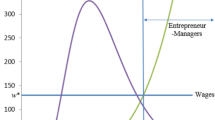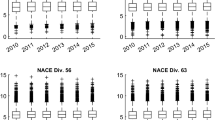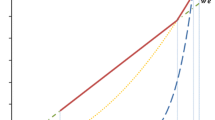Abstract
We model the distributions of firm sizes and of firms’ total factor productivity (TFP) as outcomes of a market equilibrium from the occupational decisions of individuals with different entrepreneurial skills, of working as employees, employers, or solo entrepreneurs. The model explains empirical regularities such as (i) the positive cross-section correlation between average size of firms and average labor productivity of countries, (ii) the positive association between size and TFP of firms in an economy, and (iii) the power law distribution of firm sizes. Two parameters of the model, one that measures the organizational size diseconomies and other related to the dispersion of the distribution of entrepreneurial skills in the population, appear as main determinants of the differences in firm sizes and in productivity, across economies and among firms within an economy. The results of the paper should be of interest for the design and evaluation of firm-size-dependent policies.




Similar content being viewed by others
Notes
The model assumes complete and symmetric information. The occupation choice between entrepreneurs and employees has also been explained by the different degree of risk aversion of individuals and uncertain pay-offs from entrepreneurship (Kihlstrom and Laffont 1979). When individuals learn their entrepreneurial skills from experience, then the occupational choice equilibrium is the convergence point of a dynamic process (Jovanovic 1982; Hopenhayn 1992).
In Garicano (2000) and Garicano and Rossi-Hansberg (2006), entrepreneur-managers contribute to production using their specialized knowledge to help employees solve complex problems. In the market equilibrium, there is an optimal matching of employees and managers, while in Rosen (1982), all employees can be perfectly exchanged among employers.
In Lucas (1978), the cost of capital c is equal to the shadow price of the constraint on total capital available. Rosen (1982) does not include capital as a production input. Other papers, Gollin (2008) and Guner et al. (2008), solve endogenously for the discount factor in a market equilibrium where consumers make saving decisions and producers make investment decision. We assume that financial markets optimally separate consumption from production decisions, and the users’ cost of capital is the slope of the separating line.
The proof is not reported to save space but is available from the authors on request.
In general, if θ ≠ 1 and g(e) ≠ e, the distribution of TFP will be an increasing non-linear transformation of the left-truncated distribution of entrepreneurial skills.
Suppose, for example, that we want to analyze the effect of parameter β on total output, TYT*. The analytical expression of the derivative of TYT*with respect to β (computed with the software Wolfram Mathematica) has thousands of terms, which have different signs and depend on seven exogenous parameters and three endogenous variables. It is humanly impossible to prove whether the sign of this derivative is positive or negative.
Hsieh and Klenow (2009) find that their estimated TFP for the firm in the 90th percentile of the size distribution of plants in the USA is 8.8 times the TFP estimated for the plant in the 10th percentile (22.4 for India and 11.5 for China). It is much higher than the ratio estimated here, 1.7, although in the calculations they assume constant returns to scale, while in our model, returns to scale are decreasing.
The proof is available upon request.
In general, this equation has two positive solutions, but the largest one is not an equilibrium since the corresponding values of e2 and w do not satisfy the necessary conditions b ≤ e1 ≤ e2, and w ≥ 0.
References
Axtell, R. (2001). Zipf distributions of US firm sizes. Science, 293(5536), 1818−1820. https://doi.org/10.1126/science.1062081.
Banco de España. (2014). Central de Balances 2013. In Resultados anuales de las empresas no financieras. Madrid: Banco de España.
Banerjee, A. V., & Duflo, E. (2005). Chapter 7: Growth theory through the lens of development economics. In Handbook of economic growth (pp. 473–552). Elsevier. https://doi.org/10.1016/S1574-0684(05)01007-5.
Bento, P., & Restuccia, D. (2016) Misallocation, Establishment Size and Productivity. NBER Working Paper No. 22809. https://doi.org/10.3386/w22809.
Blanchflower, D. (2004). Self-employment: More may not be better. Swedish Economic Policy Review, 11(2), 15–73.
Blau, D. M. (1987). A time-series analysis of self- employment in the United States. Journal of Political Economy, 95(3), 445–467. https://doi.org/10.1086/261466.
Bloom, N., & Van Reenen, J. (2007). Measuring and explaining management practices across firms and countries. Quarterly Journal of Economics, 122(4), 1351–1408. https://doi.org/10.1162/qjec.2007.122.4.1351.
Bloom, N., Lemos, R., Sadun, R., Scur, D., & Van Reenen, J. (2014). The new empirical economics of management. Journal of the European Economic Association, 12(4), 835–876. https://doi.org/10.1111/jeea.12094.
Bosma, N., Jones, K., Autio, E., & Levie, J. (2008). Global Entrepreneurship Monitor: 2007 Executive Report. Wellesley: Babson College and London: London Business School.
Branstetter, L., Lima, F., Taylor, L., & Venâncio, A. (2014). Do entry regulations deter entrepreneurship and job creation? Evidence from recent reforms in Portugal. Economic Journal, 124(577), 805–832. https://doi.org/10.1111/ecoj.12044.
Calvo, G., & Wellisz, S. (1980). Technology, entrepreneurs and firm size. Quarterly Journal of Economics, 95(4), 663–678. https://doi.org/10.2307/1885486.
Carree, M., van Stel, A., Thurik, R., & Wennekers, S. (2007). The relationship between economic development and business ownership revisited. Entrepreneurship and Regional Development, 19(3), 281–291 https://doi.org/10.1080/08985620701296318.
Carree, M., van Stel, A., Thurik, R., & Wennekers, S. (2002). Economic development and business ownership: An analysis using data of 23 OECD countries in the period 1976–1996. Small Business Economics, 19(3), 271–290. https://doi.org/10.1023/A:1019604426387.
Davis, S. J., & Henrekson, M. (1999). Explaining National Differences in the size and industry distribution of employment. Small Business Economics, 12(1), 59–83. https://doi.org/10.1023/A:1008078130748.
Gabaix, X. (2016). Power Laws in economics: An introduction. Journal of Economic Perspectives, 30(1), 185–206 https://doi.org/10.1257/jep.30.1.185.
Garicano, L. (2000). Hierarchies and the Organization of Knowledge in production. Journal of Political Economy, 108(5), 874–904. https://doi.org/10.1086/317671.
Garicano, L., & Rossi-Hansberg, E. (2006). Organization and inequality in a knowledge economy. Quarterly Journal of Economics, 121(4), 1383–1435. https://doi.org/10.1093/qje/121.4.1383.
Garicano, L., Lelarge, C., & Van Reenen, J. (2016). Firm size distortions and the productivity distribution: Evidence from France. American Economic Review, 106(11), 3439–3479. https://doi.org/10.1257/aer.20130232.
Gollin, D. (2008). Nobody’s business but my own: Self-employment and small Enterprise in Economic Development. Journal of Monetary Economics, 55(2), 219–233. https://doi.org/10.1016/j.jmoneco.2007.11.003.
Guner, N., Ventura, G., & Xu, Y. (2008). Macroeconomic implications of size-dependent policies. Review of Economic Dynamics, 11(4), 721–744. https://doi.org/10.1016/j.red.2008.01.005.
Gur, N., & Bjornskov, C. (2016). Trust and Delegation: Theory and evidence. Journal of Comparative Economics. https://doi.org/10.1016/j.jce.2016.02.002.
Henrekson, M., & Johansson, D. (1999). Institutional effects on the evolution of the size distribution of firms. Small Business Economics, 12(1), 11–23. https://doi.org/10.1023/A:1008002330051.
Hopenhayn, H. (1992). Entry, exit, and firm dynamics in long run equilibrium. Econometrica, 60(5), 1127–1150. https://doi.org/10.2307/2951541.
Hsieh, C., & Klenow, P. (2009). Misallocation and manufacturing TFP in China and India. Quarterly Journal of Economics, 124(4), 1403–1448. https://doi.org/10.1162/qjec.2009.124.4.1403.
Hsieh, C., & Klenow, P. (2014). The life cycle of plants in India and Mexico. Quarterly Journal of Economics, 129(3), 1035–1084. https://doi.org/10.1093/qje/qju014.
Hsieh, C., & Olken, B. (2014). The missing ‘missing middle. Journal of Economic Perspectives, 28(3), 89–108. https://doi.org/10.1257/jep.28.3.89.
Idson, T., & Oi, W. (1999). Workers are more productive in large firms. American Economic Review, 89(2), 104–108. https://doi.org/10.1257/aer.89.2.104.
IMF. (2015). Obstacles to firm growth in Spain. In Spain. Selected Issues. IMF country report no. 15/233. August 2015. Washington, D.C: International Monetary Fund https://www.imf.org/external/pubs/ft/scr/2015/cr15233.pdf.
Jovanovic, B. (1982). Selection and the evolution of industry. Econometrica, 50(3), 649–670. https://doi.org/10.2307/1912606.
Jovanovic, B. (1994). Firm formation with heterogeneous management and labor skills. Small Business Economics, 6(3), 185–191. https://doi.org/10.1007/BF01108287.
Kihlstrom, R., & Laffont, J. (1979). A general equilibrium entrepreneurial theory of firm formation based on risk aversion. Journal of Political Economy, 87(4), 719–749. https://doi.org/10.1086/260790.
Krueger, A. O. (2013). The missing middle. In N. C. Hope, A. Kochar, R. Noll, & T. N. Srinivasan (Eds.), Economic reform in India: Challenges, prospects, and lessons (pp. 299–318). Cambridge: Cambridge University Press.
Kumar, K., Rajan, R., & Zingales, L. (1999). What Determines Firm Size? NBER Working Paper No. 7208. https://doi.org/10.3386/w7208.
Lucas, R. (1978). On the size distribution of business firms. The Bell Journal of Economics, 9(2), 508–523. https://doi.org/10.2307/3003596.
Medrano-Adán, L., Salas-Fumás, V., & Sanchez-Asin, J. J. (2015). Heterogeneous entrepreneurs from occupational choices in economies with minimum wage. Small Business Economics, 44(3), 597–619. https://doi.org/10.1007/s11187-014-9610-4.
Ministerio de Industria, Energía y Turismo. (2014). Retrato de las PYME 2013. Madrid: MIET, Dirección General de Industria y de la Pequeña y Mediana Empresa.
Moral-Benito, E. (2016). Growing by learning: Firm level evidence on the size-productivity Nexus, Banco de España, D.T. No. 1613. http://www.bde.es/f/webbde/SES/Secciones/Publicaciones/PublicacionesSeriadas/DocumentosTrabajo/16/Fich/dt1613e.pdf
OECD. (2014). Chapter 2: Moving towards a more dynamic business sector in Spain. In OECD Economic Surveys: Spain 2014 (pp. 105–146). OECD Publishing. https://doi.org/10.1787/19990421
Onji, K. (2009). The response of firms to eligibility thresholds: Evidence from the Japanese value-added tax. Journal of Public Economics, 93(5–6), 766–775. https://doi.org/10.1016/j.jpubeco.2008.12.003.
Parker, S. (2009). The economics of entrepreneurship. Cambridge: Cambridge University Press.
Penrose, E. T. (1959). Theory of the Growth of the Firm, J. New York: Wiley & Sons.
Restuccia, D., & Rogerson, R. (2008). Policy distortions and aggregate productivity with heterogeneous plants. Review of Economic Dynamics, 11(4), 707–720. https://doi.org/10.1016/j.red.2008.05.002.
Rosen, S. (1982). Authority, control, and the distribution of earnings. The Bell Journal of Economics, 13(2), 311–323. https://doi.org/10.2307/3003456.
Salas-Fumás, V., Sanchez-Asin, J. J., & Storey, D. (2014). Occupational choice, number of entrepreneurs and output: Theory and empirical evidence with Spanish data. Series, Journal of the Spanish Economic Association, 5(1), 1–24. https://doi.org/10.1007/s13209-013-0103-5.
Schivardi, F., & Torrini, R. (2008). Identifying the effects of firing restrictions through size-contingent differences in regulation. Labour Economics, 15(3), 482–511. https://doi.org/10.1016/j.labeco.2007.03.003.
Shane, S. (2009). Why encouraging more people to become entrepreneurs is bad public policy. Small Business Economics, 33(2), 141–149. https://doi.org/10.1007/s11187-009-9215-5.
Syverson, C. (2011). What determines productivity? Journal of Economic Literature, 49(2), 326–365. https://doi.org/10.1257/jel.49.2.326.
Tybout, J. R. (2000). Manufacturing firms in developing countries: How well do they do, and why? Journal of Economic Literature, 38(1), 11–44. https://doi.org/10.1257/jel.38.1.11.
Van Praag, M., & van Stel, A. (2013). The more business owners, the merrier? The role of tertiary education. Small Business Economics, 41(2), 335–357. https://doi.org/10.1007/s11187-012-9436-x.
Acknowledgements
Authors acknowledge financial support from project ECO2013-48496-C4-3-R Spanish Ministry of Economy and Competitiveness, and from the DGA (Aragon Government)-ERDF (European Regional Development Fund) through the CREVALOR research group. The authors thank the valuable comments and suggestions from the two anonymous reviewers and from the Journal Editor on previous versions of the paper.
Author information
Authors and Affiliations
Corresponding author
Appendices
Appendix 1. The market equilibrium solution
From the main text, in the market equilibrium:
-
i.
Each agent makes the occupational choice (employee, solo entrepreneur, or employer-manager) that results in a higher “rent.”
-
ii.
Aggregate labor demand equals aggregate labor supply (this condition determines the equilibrium wage).
Both conditions are interrelated. The occupational choice depends on the wage that is set in the labor market, and the labor supply and demand depend on the individual occupational choices.
For a given wage w, the occupational choice of an individual with entrepreneurial skills e may be written as
where Π(e) and R(e) are, respectively, the net revenues of the solo entrepreneur and the profits of employers, as functions of her respective level of skill, Eqs. (9) and (11) in the main text. There exist two levels of skill e1 and e2 (see Fig. 1), such that
and
Individuals with skills e < e1 will choose to work as employees, individuals with skills e1 < e < e2 will prefer to be solo entrepreneurs, and individuals with skills e > e2 will become employer-managers. The level of entrepreneurial skill of the (unique) individual who is indifferent between working as an employee and becoming a solo entrepreneur is e1. Analogously, e2 is the level of entrepreneurial skills of the (unique) individual who is indifferent between becoming a solo entrepreneur and working as an employer-manager.
The occupational choices determine the aggregate labor supply \( S(w)=\underset{b}{\overset{e_1\left({w}^{\ast}\right)}{\int }}d\Gamma (e) \), and the aggregate labor demand \( D(w)=\underset{e_2\left(w\ast \right)}{\overset{+\infty }{\int }}L\left(e;{w}^{\ast },c\right)d\Gamma (e) \). In equilibrium, the two must be equal, so the market equilibrium conditions are given by the three equations:
where L(e, w, c), Π(e), and R(e) are given by Eqs. (9)–(11) in the main text, and Γ(e) is the Pareto-cumulative distribution function with parameters (a, b). After substituting these equations (demand for employees, profits of employers, and revenues of the solo self-employed), and doing some calculations, we obtain the following system of equations in (e1, e2, w) that characterize the equilibrium:
There is no closed-form solution to this non-linear system of equations. Although these equations are complex, we can prove existence and uniquenessFootnote 8 of equilibrium, provided that the necessary condition β(a − 1) > 1 is satisfied, and we can solve them numerically, implicitly defining the equilibrium values of e1, e2, and w as functions of the seven exogenous parameters e1∗(θ, μ, c, ρ, β, a, b), e2∗(θ, μ, c, ρ, β, a, b), and w∗(θ, μ, c, ρ, β, a, b).
Alternatively, we can express the equilibrium values of w and e2 as functions of e1, and then find the equilibrium value of e1 by solving a single equation. Proceeding in this way, the equilibrium value of w (as a function of e1) is directly given by (21) and the equilibrium value of e2 is given by
where \( {f}_1\left({e}_1\right)={\left({\left(\frac{c{\theta}^{\rho }{e}_1^{\rho }}{1-\mu}\right)}^{\frac{1}{1+\rho }}-c\right)}^{\frac{1}{1+\rho }}{\left({\left(\frac{\theta \left(1-\mu \right){e}_1}{c}\right)}^{\frac{\rho }{1+\rho }}-\left(1-\mu \right)\right)}^{\frac{1}{\rho \left(1+\rho \right)}} \).
Finally, the equilibrium value of e1 is given by the uniqueFootnote 9 solution to the following equation that satisfies conditions b ≤ e1 ≤ e2 and w ≥ 0:
where,
This equation has no closed-form solution but can be solved numerically, implicitly defining the equilibrium value of e1 as a function of the exogenous parameters \( {e}_1^{\ast}\left(\theta, \mu, c,\rho, \beta, a,b\right) \)
Once the equilibrium value of e1 is found, it is straightforward to obtain the equilibrium wage, the equilibrium value of e2, and any other endogenous variable (labor supply, equilibrium number of employees, and so on).
Appendix 2. Calibration of the parameters of the model
The exogenous parameters of the model are (θ, μ, c, ρ, β, a, b). In the main text, we justify the initial values for parameters c = 0.12, θ = 1, ρ = 0.5 (σ = 2/3), and μ = 0.75. Therefore, we have parameters a, b, and β remaining for calibration. For the calibration, we use information on the proportions of those employed as employees and as employers plus managers, together with information on the proportion of those occupied in firms with 250 employees or more, and the market equilibrium conditions of the model:
where Lmin = L(w; e2) is given in Result 1b, and w, e1, and e2 are given by the market equilibrium conditions, Eqs. (21)–(23) of Appendix 1. Substituting Lmin, the complete system of equations is
After substituting θ = 1, c = 0.12, μ = 0.75, and ρ = 0.5 into these equations, we obtain the following equations system on six unknowns: e1, e2, w, a, b, and β.
The numerical solution to this system of equations provides the calibrated values of the parameters of the model, as well as the values of the other endogenous variables: β = 0.36, a = 4.775, b = 3.269, w = 5.52, e1 = 4.53, and e2 = 5.48.
Rights and permissions
About this article
Cite this article
Medrano-Adán, L., Salas-Fumás, V. & Javier Sanchez-Asin, J. Firm size and productivity from occupational choices. Small Bus Econ 53, 243–267 (2019). https://doi.org/10.1007/s11187-018-0048-y
Accepted:
Published:
Issue Date:
DOI: https://doi.org/10.1007/s11187-018-0048-y
Keywords
- Occupational choices
- Distribution of firm sizes
- Productivity
- Power law distribution
- Firm-size-dependent policies




